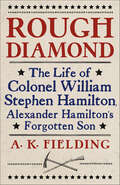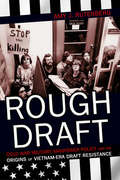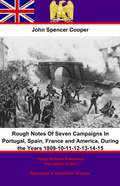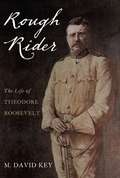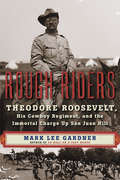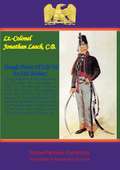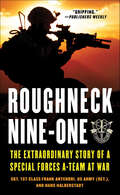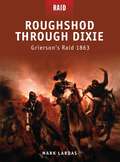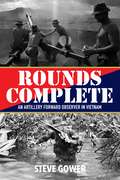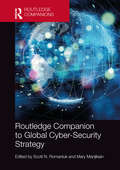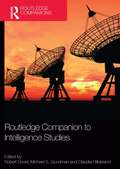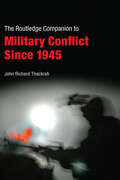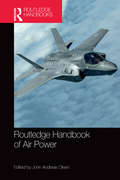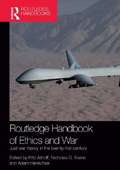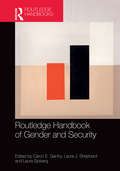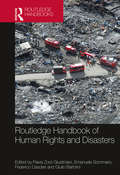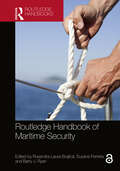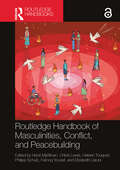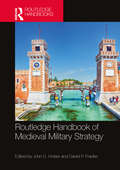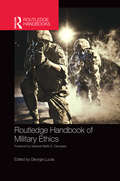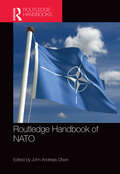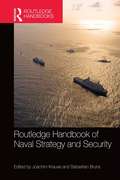- Table View
- List View
Rough Diamond: The Life of Colonel William Stephen Hamilton, Alexander Hamilton's Forgotten Son
by A. K. FieldingSolider, politician, miner, pioneer, scion of a Founding Father, William Stephen Hamilton led a prolific life. Rough Diamond: The Life of Colonel William Stephen Hamilton examines the tumultuous early Republic period of American history through the life of Alexander Hamilton's son.Born in New York in 1797, the fifth son of Alexander Hamilton, he was only seven when his father was infamously killed in a duel with Vice President Aaron Burr. After resigning from West Point, Hamilton moved to frontier Illinois in 1817. The famous name of Hamilton that may have acquired him rank and prestige at one time was meaningless in a Midwestern frontier society driven by the Jacksonians. Yet, despite being hurled into a clash of economic, political, and cultural cultures, Hamilton determined to live his life by his own rules. A veteran of the Winnebago and Black Hawk Wars, Hamilton was elected to the Illinois House of Representatives before moving to the Wisconsin territory, where he founded the mining town of Hamilton's Diggings (Wiota, WI). When gold was discovered in California in 1848, he traveled west, where he would die in Sacramento in 1850.In Rough Diamond: The Life of Colonel William Stephen Hamilton, author A. K. Fielding expands the story of the Hamilton family. Hamilton's life offers a firsthand account of the formation of the Midwestern states, the realities of life on the frontier, and mass migration caused by the California Gold Rush.
Rough Draft: Cold War Military Manpower Policy and the Origins of Vietnam-Era Draft Resistance
by Amy J. RutenbergRough Draft draws the curtain on the race and class inequities of the Selective Service during the Vietnam War. Amy J. Rutenberg argues that policy makers' idealized conceptions of Cold War middle-class masculinity directly affected whom they targeted for conscription and also for deferment. Federal officials believed that college educated men could protect the nation from the threat of communism more effectively as civilians than as soldiers. The availability of deferments for this group mushroomed between 1945 and 1965, making it less and less likely that middle-class white men would serve in the Cold War army. Meanwhile, officials used the War on Poverty to target poorer and racialized men for conscription in the hopes that military service would offer them skills they could use in civilian life.As Rutenberg shows, manpower policies between World War II and the Vietnam War had unintended consequences. While some men resisted military service in Vietnam for reasons of political conscience, most did so because manpower polices made it possible. By shielding middle-class breadwinners in the name of national security, policymakers militarized certain civilian roles—a move that, ironically, separated military service from the obligations of masculine citizenship and, ultimately, helped kill the draft in the United States.
Rough Notes Of Seven Campaigns In Portugal, Spain, France and America, During the Years 1809-10-11-12-13-14-15
by John Spencer CooperThis ebook is purpose built and is proof-read and re-type set from the original to provide an outstanding experience of reflowing text for an ebook reader. A much sought-after volume of reminiscences from the British Army, taken by a sergeant in the 7th Regiment of Foot, or the Royal Fusiliers. Sergeant Cooper was an educated man and, inspired by the spectre of the Napoleonic invasion fleet sitting in the famous Boulogne camps, he volunteered to serve his country. He chose to transfer to a regular army regiment which would allow him to fight the French overseas, as the threat of invasion had been removed as Napoleon concentrated on further continental conquests. His account of the campaigns in which he fought, from Talavera until Toulouse (Talavera, Busaco, Albuera, Vittoria, Orthez, Toulouse, as well as the sieges of Badajoz and Cuidad Rodrigo and the abortive campaign to New Orleans), are tightly edited by the Author to omit details and accounts to which he was not an eye-witness. He wrote his notes at the time and, except for one volume going missing whilst he was in hospital, they offered a contemporaneous source of insight into the daily lives of the rank and file. His descriptions of the actions and battles he engaged in are intelligent, vivid and full of interesting details. An excellent memoir, warmly recommended. Text taken, whole and complete, from the 1914 second edition, published G. & T. Coward Ltd, Carlisle. Original -150 pages Author - John Spencer Cooper (1787-????) Illustration - Portrait of the Author Linked TOC
Rough Rider
by David KeyRough Rider is a snapshot study of the significant career of President Theodore Roosevelt. Partly biographical sketch and partly analysis, the book provides an overview of his actions, ideals, and written works, highlighting important events from Roosevelt's early public life, his presidency, and later career. David Key sees Roosevel as a statesman who well understood how to create his own popular image, but equally important was Roosevelt's place as one of the foremost historians of his time, a man who understood the traditional criteria for greatness and did not hesitate to shape his own legacy. Written especially for college students, Rough Rider examines pertinent primary sources and critical analyses of other historians to aid in understanding the legacy of Theodore Roosevelt.
Rough Riders: Theodore Roosevelt, His Cowboy Regiment, and the Immortal Charge Up San Juan Hill
by Mark Lee GardnerThe first definitive account of this legendary fighting force and its extraordinary leader, Theodore Roosevelt, Mark Lee Gardner's Rough Riders is narrative nonfiction at its most invigorating and compulsively readable. Its dramatic unfolding of a familiar, yet not-fully-known story will remind readers of James Swanson's Manhunt.Two months after the sinking of the USS Maine in Havana Harbor in February 1898, Congress authorized President McKinley to recruit a volunteer army to drive the Spaniards from Cuba. From this army emerged the legendary "Rough Riders," a mounted regiment drawn from America's western territories and led by the indomitable Theodore Roosevelt. Its ranks included not only cowboys and other westerners, but several Ivy Leaguers and clubmen, many of them friends of "TR." Roosevelt and his men quickly came to symbolize American ruggedness, daring, and individualism. He led them to victory in the famed Battle at San Juan Hill, which made TR a national hero and cemented the Rough Riders' place in history.Now, Mark Lee Gardner synthesizes previously unknown primary accounts as well as period newspaper articles, letters, and diaries from public and private archives in Arizona, Texas, Oklahoma, New Mexico, Boston, and Washington, DC, to produce this authoritative chronicle. He breathes fresh life into the Rough Riders and pays tribute to their daring feats and indomitable leader. Gardner also explores lesser-known aspects of the story, including their relationship with the African-American "Buffalo Soldiers, with whom they fought side by side at San Juan Hill.Rich with action, violence, camaraderie, and courage, Rough Riders sheds new light on the Theodore Roosevelt saga--and on one of the most thrilling chapters in American history.
Rough Sketches Of Life Of An Old Soldier;: In The Campaigns From 1808-1814, With The Light Division; The Netherlands In 1815;
by Pickle Partners Publishing Lieutenant-Colonel Jonathan Leach C.B.This ebook is purpose built and is proof-read and re-type set from the original to provide an outstanding experience of reflowing text for an ebook reader. Leach describes his exploits with the 95th Rifles, including the expedition to Denmark, the battles of Rolica, Vimiero, Busaco, Salamanca, Vitoria, and the Nivelle, culminating in the battle of Waterloo, where he was posted to the sand-pit next to the crucial position of La Haye Sainte. He also recounts the vicissitudes of campaigning in the Peninsular, vividly describing those under his command and those of higher rank that he came into contact with. Full Title of the book is - Rough Sketches Of Life Of An Old Soldier; During A Service In The West Indies; At The Siege Of Copenhagen In 1807; In The Peninsula And The South Of France In The Campaigns From 1808 To 1814, With The Light Division; In The Netherlands In 1815; Including The Battles Of Quatre Bras And Waterloo: With A Slight Sketch Of The Three Years Passed By The Army Of Occupation In France, &c. &c. &c. A classic of the genre. Includes TOC.
Rough Terrain: A Fake Boyfriend Gay Romance (Out of Uniform #7)
by Annabeth Albert“Whether making my heart melt, or my head burst into flames — Annabeth Albert draws the reader in and keeps them captivated.” —Gay Book ReviewsThe camping trip from hell may be the first stop on the road to happily-ever-after. Navy SEAL Renzo Bianchi has a soft spot for Canaan Finley, and not only because the man makes a mean smoothie. He’s the first guy to get Renzo’s motor revving in a long time. But when he agrees to Canaan’s insane charade—one all-access fake boyfriend, coming right up—he never expects more than a fling.Creating a hot Italian SEAL boyfriend to save face seemed like a good idea…until his friends called Canaan’s bluff. Now he’s setting off into the woods with the very man who inspired his deception, and Canaan is not the outdoorsy type. The sparks are already flying when a flash flood separates them from their group, leaving Renzo and Canaan very much trapped…very much alone in the wilderness.Working together to come up with a plan for survival is sexier than either of them expects. But back in the real world, being a couple is bringing its own set of hazards…Don’t miss the Out of Uniform series by Annabeth Albert! Order your copy of Off Base, At Attention, On Point, Wheels Up, Squared Away and Tight Quarters today! One-click with confidence. This title is part of the Carina Press Romance Promise: all the romance you’re looking for with an HEA/HFN. It’s a promise!
Roughneck Nine-One: The Extraordinary Story of a Special Forces A-team at War
by Hans Halberstadt Frank AntenoriThis Iraq War memoir shares “a gritty inside look at a Special Forces team at war” and how the author’s outgunned Green Berets won a dramatic battle (Publishers Weekly).On April 6th, 2003, twenty-six Green Berets, including those of Sergeant 1st Class Frank Antenori’s Special Forces A-team (call sign Roughneck Nine-One), confronted a vastly superior force—including battle tanks and more than 150 well-trained and well-equipped soldiers—at a remote crossroads near the small village of Debecka, Iraq.Along the way, they endured a US Navy F-14 dropping a 500-pound bomb on supporting Kurdish Peshmerga fighters, the ever-present threat of WMDs, and countless other deadly obstacles.This is the never-before-told, no-holds-barred story of how one Special Forces A-team recruited and organized, trained and eventually fought—and won—a legendary conflict that will influence American military doctrine for years to come.
Roughshod Through Dixie - Grierson's Raid 1863
by Johnny Shumate Mark LardasOn April 17, 1863 Benjamin Grierson led a force of 1,700 Union cavalrymen across enemy lines into the Confederate-held Tennessee in a bold diversionary raid. Over the next seventeen days, Grierson's horsemen caused havoc by destroying railroad lines, attacking outposts, burning military stores and fighting numerous small actions, before breaking back through the lines at Baton Rouge. The raid was a tremendous success, not only by virtue of the destruction it caused, but also because the Confederates were forced to divert thousands of troops away from the front lines during General Grant's critical Vicksburg offensive. This book tells the complete story of one of the most daring Union raids of the war.
Rounds Complete: An Artillery Forward Observer in Vietnam
by Steve GowerIn 1966, Steve Gower, a young gunner captain in the 101st Field Battery, was sent to Vietnam. He would serve in what is arguably Australia’s most controversial war in the dangerous role of forward observer with the 5th and 6th battalions of the Royal Australian Regiment. The definition of his role stated simply that he was to provide ‘timely, accurate and effective fire support’, his task to guide the guns of the Australian artillery, sited many kilometres away, in providing deadly firepower to support the soldiers who battled both the jungle and its shadowy inhabitants. Gower would learn quickly that the definition omitted to mention the terror and nerve-jangling tension of jungle warfare he was to experience as a forward observer. In Rounds Complete, Gower describes living the life of an infantry soldier, tramping the ground and joining his infantry mates in a variety of operations including search and destroy, cordon and search, heliborne and road-protection operations and company patrols from forward operating bases. He describes the inevitable boredom and monotony of the routine, contrasting this with the heightened senses of the men as they prepared to move forward with the ‘safety catch off’, the nervous anticipation of what might lie ahead, the exhilaration and, above all, the camaraderie. Gower is positive about his time in Vietnam and, perhaps surprisingly for one who saw action in this contentious war, is supportive of Australia's commitment, referring to the conflict as the last time the Army was permitted the ‘unfettered, all-arms prosecution of a war’. Rounds Complete is a frank and compelling tribute to men who served just as nobly as their AIF predecessors but, until recent times, were denied their nation’s gratitude. Their fight for understanding continues.
Routledge Companion to Global Cyber-Security Strategy
by Mary Manjikian Scott N. RomaniukThis companion provides the most comprehensive and up-to-date comparative overview of the cyber-security strategies and doctrines of the major states and actors in Europe, North America, South America, Africa, and Asia. The volume offers an introduction to each nation’s cyber-security strategy and policy, along with a list of resources in English that may be consulted for those wishing to go into greater depth. Each chapter is written by a leading academic or policy specialist, and contains the following sections: overview of national cyber-security strategy; concepts and definitions; exploration of cyber-security issues as they relate to international law and governance; critical examinations of cyber partners at home and abroad; legislative developments and processes; dimensions of cybercrime and cyberterrorism; implications of cyber-security policies and strategies. This book will be of much interest to students and practitioners in the fields of cyber-security, national security, strategic studies, foreign policy, and international relations.
Routledge Companion to Intelligence Studies
by Robert Dover Michael S. Goodman Claudia HillebrandThe Routledge Companion to Intelligence Studies provides a broad overview of the growing field of intelligence studies. The recent growth of interest in intelligence and security studies has led to an increased demand for popular depictions of intelligence and reference works to explain the architecture and underpinnings of intelligence activity. Divided into five comprehensive sections, this Companion provides a strong survey of the cutting-edge research in the field of intelligence studies: Part I: The evolution of intelligence studies; Part II: Abstract approaches to intelligence; Part III: Historical approaches to intelligence; Part IV: Systems of intelligence; Part V: Contemporary challenges. With a broad focus on the origins, practices and nature of intelligence, the book not only addresses classical issues, but also examines topics of recent interest in security studies. The overarching aim is to reveal the rich tapestry of intelligence studies in both a sophisticated and accessible way. This Companion will be essential reading for students of intelligence studies and strategic studies, and highly recommended for students of defence studies, foreign policy, Cold War studies, diplomacy and international relations in general.
Routledge Companion to Military Conflict since 1945 (Routledge Companions)
by John Richard ThackrahFrom the depths of the Cold War to the War on Terror, The Routledge Companion to Military Conflict since 1945 is an in-depth and comprehensive reference guide to the confrontations that have shaped the modern age. Covering the personalities, the wars and the ideas that have been central to military conflict in the last sixty years, this book includes discussion of: specific campaigns from Vietnam to Iraq international organizations, including NATO, the UN and the Arab League leading historical figures, from Idi Amin to George W. Bush genocides, Proxy wars and the Guerrilla campaigns key concepts in international relations, from Defense to Chemical Warfare the causes of conflict from the religion to the fight for diminishing resources. Exploring all of this and more in an easy to use A-Z format with guides to further reading, this is an essential resource for students of international relations, military history and conflict and strategic studies at all levels.
Routledge Handbook of Air Power
by John Andreas OlsenThe Routledge Handbook of Air Power offers a comprehensive overview of the political purposes and military importance of air power. Despite its increasing significance in international relations, statecraft and war, the phenomenon of air power remains controversial and little understood beyond its tactical and technological prominence. This volume provides a comprehensive survey designed to contribute to a deep and sophisticated understanding of air power. Containing contributions from academics and service personnel, the book comprises five sections: - Part I Foundation: the essence of air power - Part II Roles and functions: delivering air power - Part III Cross-domain integration: applying air power - Part IV Political–social–economic environment: air power in its strategic context - Part V Case studies: air power in its national context Examining a series of themes and factors that contribute to an understanding of the utility and applicability of air power, this Handbook focuses on the essence of air power, identifies its roles and functions, and places air power in its wider strategic and national contexts. The Routledge Handbook of Air Power will be of great interest to students of air power, strategic studies, defence studies, security studies and IR, as well as to military professionals and policy-makers.
Routledge Handbook of Defence Studies
by David J. Galbreath John R. DeniThe Routledge Handbook of Defence Studies provides a comprehensive collection of essays on contemporary defence studies by leading international scholars. Defence studies is a multi-disciplinary study of how agents, predominantly states, prepare for and go to war. Whereas security studies has been broadened and stretched to cover at times the near totality of international and domestic affairs, and war studies has come to mean not just operations and tactics but also experiences and outcomes, defence studies remains a coherent area of study primarily aimed at how defence policy changes over time and in relation to stimulating factors such as alterations in power, strategy and technology. This new Handbook offers a complete landscape of this area of study and contributes to a review of defence studies in terms of policy, security and war, but also looks forward to new challenges to existing conceptions of defence and how this is changing as states and their militaries also change. The volume is divided into four thematic sections: Defence as Policy; Defence Practice; Operations and Tactics; and Contemporary Defence Issues. The ability to review the field while also looking forward to further research is an important element of a sustainable text on defence studies. In as much as this volume is able to highlight the main themes of defence studies, it also offers an in-depth look into how defence issues can be examined and compared in a contemporary setting. This Handbook will be of great interest to students of defence studies, strategic studies, war studies, security studies and IR.
Routledge Handbook of Ethics and War: Just War Theory in the 21st Century (Routledge International Handbooks)
by Fritz Allhoff Nicholas G. Evans Adam HenschkeThis new Handbook offers a comprehensive overview of contemporary extensions and alternatives to the just war tradition in the field of the ethics of war. The modern history of just war has typically assumed the primacy of four particular elements: jus ad bellum, jus in bello, the state actor, and the solider. This book will put these four elements under close scrutiny, and will explore how they fare given the following challenges: • What role do the traditional elements of jus ad bellum and jus in bello—and the constituent principles that follow from this distinction—play in modern warfare? Do they adequately account for a normative theory of war? • What is the role of the state in warfare? Is it or should it be the primary actor in just war theory? • Can a just war be understood simply as a response to territorial aggression between state actors, or should other actions be accommodated under legitimate recourse to armed conflict? • Is the idea of combatant qua state-employed soldier a valid ethical characterization of actors in modern warfare? • What role does the technological backdrop of modern warfare play in understanding and realizing just war theories?Over the course of three key sections, the contributors examine these challenges to the just war tradition in a way that invigorates existing discussions and generates new debate on topical and prospective issues in just war theory. This book will be of great interest to students of just war theory, war and ethics, peace and conflict studies, philosophy and security studies.
Routledge Handbook of Gender and Security
by Laura Sjoberg Laura J. Shepherd Caron E. GentryThis handbook provides a comprehensive look at the study of gender and security in global politics. The volume is based on the core argument that gender is conceptually necessary to thinking about central questions of security; analytically important for thinking about cause and effect in security; and politically important for considering possibilities of making the world better in the future. Contributions to the volume look at various aspects of studying gender and security through diverse lenses that engage diverse feminisms, with diverse policy concerns, and working with diverse theoretical contributions from scholars of security more broadly. It is grouped into four thematic sections: Gendered approaches to security (including theoretical, conceptual, and methodological approaches); Gendered insecurities in global politics (including the ways insecurity in global politics is distributed and read on the basis of gender); Gendered practices of security (including how policy practice and theory work together, or do not); Gendered security institutions (across a wide variety of spaces and places in global politics). This handbook will be of great interest to students of gender studies, security studies and IR in general.
Routledge Handbook of Human Rights and Disasters (Routledge Studies in Humanitarian Action)
by Federico Casolari Flavia Zorzi Giustiniani Emanuele Sommario Giulio BartoliniThe Routledge Handbook of Human Rights and Disasters provides the first comprehensive review of the role played by international human rights law in the prevention and management of natural and technological disasters. Each chapter is written by a leading expert and offers a state-of-the-art overview of a significant topic within the field. In addition to focussing on the role of human rights obligations in disaster preparedness and response, the volume offers a broader perspective by examining how human rights law interacts with other legal regimes and by addressing the challenges facing humanitarian organizations. Preceded by a foreword by the International Law Commission’s Special Rapporteur on the Protection of Persons in the Event of Disasters, the volume is divided into four parts: Part I: Human rights law and disasters in the framework of public international law Part II: Role and application of human rights law in disaster settings Part III: (Categories of) rights of particular significance in a disaster context Part IV: Protection of vulnerable groups in disaster settings Providing up-to-date and authoritative contributions covering the key aspects of human rights protection in disaster settings, this volume will be of great interest to scholars and students of humanitarianism, international law, EU law, disaster management and international relations, as well as to practitioners in the field of disaster management.
Routledge Handbook of Maritime Security
by Susana Ferreira Barry J. Ryan Ruxandra-Laura BoşilcăThis handbook offers a critical and substantial analysis of maritime security and documents the most pressing strategic, economic, socio-cultural and legal questions surrounding it. Written by leading international experts, this comprehensive volume presents a wide variety of theoretical positions on maritime security, detailing its achievements and outlining outstanding issues faced by those in the field. The book includes studies which cover the entire spectrum of activity along which maritime security is developing, including, piracy, cyber security, energy security, terrorism, narco-subs and illegal fishing. Demonstrating the transformative character and potential of the topic, the book is divided into two parts. The first part exhibits a range of perspectives and new approaches to maritime security, and the second explores emerging developments in the practice of security at sea, as well as regional studies written by local maritime security experts. Taken together, these contributions provide a compelling account of the evolving maritime security environment, casting fresh light on theoretical and empirical aspects.The book will be of much interest to practitioners and students of maritime security, naval studies, security studies, maritime history, and International Relations in general.
Routledge Handbook of Maritime Security
by Ruxandra-Laura BoşilcăThis handbook offers a critical and substantial analysis of maritime security and documents the most pressing strategic, economic, socio-cultural and legal questions surrounding it. Written by leading international experts, this comprehensive volume presents a wide variety of theoretical positions on maritime security, detailing its achievements and outlining outstanding issues faced by those in the field. The book includes studies which cover the entire spectrum of activity along which maritime security is developing, including, piracy, cyber security, energy security, terrorism, narco-subs and illegal fishing. Demonstrating the transformative character and potential of the topic, the book is divided into two parts. The first part exhibits a range of perspectives and new approaches to maritime security, and the second explores emerging developments in the practice of security at sea, as well as regional studies written by local maritime security experts. Taken together, these contributions provide a compelling account of the evolving maritime security environment, casting fresh light on theoretical and empirical aspects. The book will be of much interest to practitioners and students of maritime security, naval studies, security studies, maritime history, and International Relations in general.
Routledge Handbook of Masculinities, Conflict, and Peacebuilding
by Heleen Touquet Henri Myrttinen Farooq Yousaf Philipp Schulz Chloé Lewis Elizabeth LaruniThis handbook engages with and broadens current debates on men and masculinities in conflict and peacebuilding.Through an expansive range of chapters across a unique array of geographical settings, the volume shatters prevailing assumptions about men’s relationship to conflict and its wake. Situated across scholarship, policy, and practice, the contributions offer new possibilities for a more complex and complete picture of the gendered tapestries of conflict, peace, and the spaces in between. The handbook combines feminist, intersectional, relational, decolonial, and queer perspectives on the conceptualisation of masculinities in conflict and peacebuilding. This approach provides us with the tools to go beyond direct, physical, conflict-related violence to examine less visible forms of violence and power as well as other ways in which masculinities interact with conflict and peace. In doing so, the book permits a multi-faceted view of men’s roles, relationships, vulnerabilities, and non-violent agencies in conflict and peacebuilding across scholarship, policy, and practice.This book will be of much interest to students of gender, masculinities, peace and conflict studies, and international relations.Chapter 1, 3, 9, 13, and 30 of this book are freely available as a downloadable Open Access PDF at http://www.taylorfrancis.com under a Creative Commons Attribution-Non Commercial-No Derivatives (CC-BY-NC-ND) 4.0 license.Chapters 19 and 25 of this book is freely available as a downloadable Open Access PDF at http://www.taylorfrancis.com under a Creative Commons Attribution (CC-BY) 4.0 license.
Routledge Handbook of Medieval Military Strategy
by Daniel P. FrankeThis Handbook provides the first comprehensive and global analysis of medieval military strategy, covering the period from the sixth to the seventeenth century.Challenging the widely held notion in modern strategic studies that medieval strategy was non-existent, the Handbook brings together leading scholars to explore a range of literatures, campaigns, laws, and contexts that highlight medieval warfare’s multifaceted contours. The scope of the work is ambitious, with over 30 chapters dedicated to analyzing strategy across six continents. From Charlemagne to Henry V and Scandinavia to Florence; southbound to Morocco then across the Sahara to Kongo; past the Adriatic to Byzantium and Georgia and the Crusades and Egypt; further still into Indian and Chinese dynasties and Japan; and finally, to Central and South America—this Handbook provides ready access to military strategy across the medieval world stage. In the process, it fills a significant gap in the history of strategy and serves to connect the ancient world with the modern, demonstrating that—whatever the period—military leaders have consistently plied warfare in the pursuit of greater ends.This Handbook will be of much interest to researchers and students of military strategy, medieval military history, and strategic studies in general.
Routledge Handbook of Military Ethics
by George LucasThe Routledge Handbook of Military Ethics is a comprehensive reference work that addresses concerns held in common by the military services of many nations. It attempts to discern both moral dilemmas and clusters of moral principles held in common by all practitioners of this profession, regardless of nation or culture. Comprising essays by contributors drawn from the four service branches (Army, Navy, Air Force, and Marine corps) as well as civilian academics specializing in this field, this handbook discusses the relationship of "ethics" in the military setting to applied and professional ethics generally. Leading scholars and senior military practitioners from countries including the US, UK, France, China, Australia and Japan, discuss various national cultural views of the moral dimensions of military service. With reference to the responsibilities of professional orientation and education, as well as the challenges posed by recent technological developments, this handbook examines the difficulties underpinning the fundamental framework of military service. This book will be of much interest to students of military studies, war theory, ethics philosophy, sociology, war and conflict studies, and security studies.
Routledge Handbook of NATO
by John Andreas OlsenThis handbook provides a comprehensive survey of the development and importance of the North Atlantic Treaty Organisation (NATO), its role in international relations and its influence on history.The volume examines the Alliance’s evolution in breadth, depth and context by analysing and explaining why and how NATO has endured and remained relevant since its creation. To present an inclusive study of the Alliance’s activities and milestone events and to offer a glimpse of future challenges, the book’s 29 chapters fall into six thematic sections that act as frameworks and allow the exploration of specific topics that pertain to the evolution of NATO: Part I: History of NATO, 1949–2024 Part II: Key Enduring Themes, 1949–2024 Part III: Military Operations, 1995–2024 Part IV: National Perspectives, 1949–2024 Part V: Regional Perspectives, 1949–2024 Part VI: Future Prospects, 2024– This handbook will be of much interest to students and researchers of NATO, strategic studies, defence studies and International Relations, as well as for staff and fellows at security- and defence-oriented think tanks and government officials, military personnel and other practitioners in the areas of foreign affairs and defence.
Routledge Handbook of Naval Strategy and Security
by Sebastian Bruns Joachim KrauseThis new handbook provides a comprehensive overview of the issues facing naval strategy and security in the twenty-first century. Featuring contributions from some of the world’s premier researchers and practitioners in the field of naval strategy and security, this handbook covers naval security issues in diverse regions of the world, from the Indian Ocean and the Mediterranean to the Arctic and the piracy-prone waters off East Africa’s coast. It outlines major policy challenges arising from competing claims, transnational organized crime and maritime terrorism, and details national and alliance reactions to these problems. While this volume provides detailed analyses on operational, judicial, and legislative consequences that contemporary maritime security threats pose, it also places a specific emphasis on naval strategy. With a public very much focused on the softer constabulary roles naval forces play (such as humanitarian assistance, disaster relief, naval diplomacy, maintenance of good order at sea), the overarching hard-power role of navies has been pushed into the background. In fact, navies and seapower have been notably absent from many recent academic discussions and deliberations of maritime security. This handbook provides a much-desired addition to the literature for researchers and analysts in the social sciences on the relationship between security policy and military means on, under, and from the sea. It comprehensively explains the state of naval security in this maritime century and the role of naval forces in it. This book will be of much interest to students of naval security and naval strategy, security studies and IR, as well as practitioners in the field.
